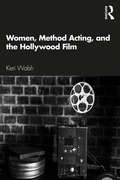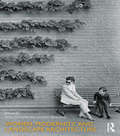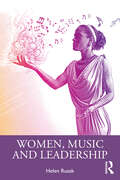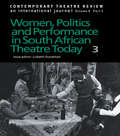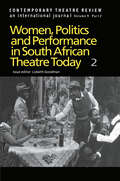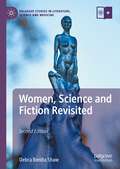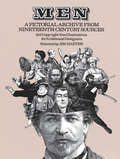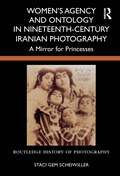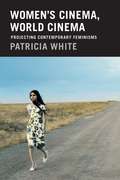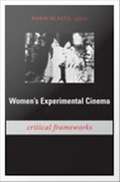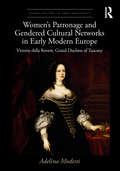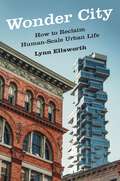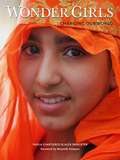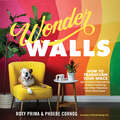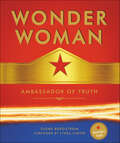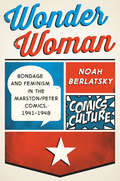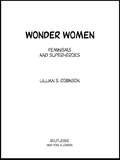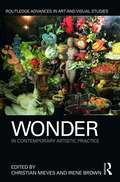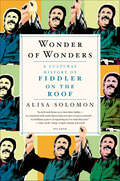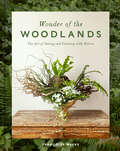- Table View
- List View
Women, Collective Creation, and Devised Performance
by Kathryn Mederos Syssoyeva Scott ProudfitThis book explores therole and centrality of women in the development of collaborative theatrepractice, alongside the significance of collective creation and devising in thedevelopment of the modern theatre. Tracing a web of women theatremakers in Europeand North America, this book explores the connections between early twentiethcentury collective theatre practices such as workers theatre and the dramaticplay movement, and the subsequent spread of theatrical devising. Chaptersinvestigate the work of the Settlement Houses, total theatre in 1920s' France,the mid-century avant-garde and New Left collectives, the nomadic performancesof Europe's transnational theatre troupes, street-theatre protests, andcontemporary devising. In so doing, the book further elucidates a history of moderntheatre begun in A History of CollectiveCreation (2013) and CollectiveCreation in Contemporary Performance (2013), in which the seeminglymarginal and disparate practices of collective creation and devising arerevealed as central--and women theatremakers revealed as progenitors of thesepractices.
Women, Method Acting, and the Hollywood Film
by Keri WalshWomen, Method Acting, and the Hollywood Film is the first study dedicated to understanding the work of female Method actors on film. While Method acting on film has typically been associated with the explosive machismo of actors like Marlon Brando and Robert De Niro, this book explores an alternate tradition within the Method—the work that women from the Actors Studio did in Hollywood. Covering the period from the end of the Second World War until the 1970s, this study shows how the women associated with the Actors Studio increasingly used Method acting in ways that were compatible with their burgeoning feminist political commitments and developed a style of feminist Method acting. The book examines the complex intersection of Method acting, sexuality, and gender by analyzing performances such as Kim Hunter’s in A Streetcar Named Desire, Julie Harris’s in The Member of the Wedding, Shelley Winters’s in The Big Knife, Geraldine Page’s in Sweet Bird of Youth, and Jane Fonda’s in Coming Home. Challenging the longstanding assumption that Method acting’s approaches were harmful to women and incompatible with feminism, this book argues that some of Hollywood’s most interesting female actors, and leading feminists, emerged from the Actors Studio in the period between the 1950s and the 1970s. Written for students and scholars of Film Studies, Cultural Studies, Theatre and Performance Studies, and Gender Studies, Women, Method Acting, and the Hollywood Film reshapes the way we think of a central strain in American screen acting, and in doing so, allows women a new stake in that tradition.
Women, Modernity, and Landscape Architecture
by Sonja Dümpelmann John BeardsleyModernity was critically important to the formation and evolution of landscape architecture, yet its histories in the discipline are still being written. This book looks closely at the work and influences of some of the least studied figures of the era: established and less well-known female landscape architects who pursued modernist ideals in their designs. The women discussed in this volume belong to the pioneering first two generations of professional landscape architects and were outstanding in the field. They not only developed notable practices but some also became leaders in landscape architectural education as the first professors in the discipline, or prolific lecturers and authors. As early professionals who navigated the world of a male-dominated intellectual and menial work force they were exponents of modernity. In addition, many personalities discussed in this volume were either figures of transition between tradition and modernism (like Silvia Crowe, Maria Teresa Parpagliolo), or they fully embraced and furthered the modernist agenda (like Rosa Kliass, Cornelia Oberlander). The chapters offer new perspectives and contribute to the development of a more balanced and integrated landscape architectural historiography of the twentieth century. Contributions come from practitioners and academics who discuss women based in USA, Canada, Brazil, New Zealand, South Africa, the former USSR, Sweden, Britain, Germany, Austria, France and Italy. Ideal reading for those studying landscape history, women’s studies and cultural geography.
Women, Music and Leadership
by Helen RusakWomen, Music and Leadership offers a wide-ranging survey of women in musical leadership and their experiences, highlighting women’s achievements and considering how they negotiate the challenges of the leadership space in music. Women have always participated in music as performers, teachers, composers and professionals, but remain underrepresented in leadership positions. Covering women’s leadership across a wide variety of roles and musical genres, this book addresses women in classical music, gospel, blues, jazz, popular music, electronic music and non-Western musical contexts, and considers women working as composers, as conductors, and in music management and the music business. Each chapter includes several case studies of women’s careers, exploring their groundbreaking contributions to music and the challenges they faced as leaders. Connecting management theory and leadership research with feminist musicology, this book paints a new picture of women’s major contributions as leaders in music and their ongoing struggles for equity. It will be relevant to students and scholars in arts and music management, as well as all those studying music, gender or leadership, and women music professionals.
Women, Politics and Performance in South African Theatre Today Vol 3: Volume 3 (Contemporary Theatre Review Ser. #Vols. 9, Pts. 3.)
by Lizbeth GoodmanThis title available in eBook format. Click here for more information.Visit our eBookstore at: www.ebookstore.tandf.co.uk.
Women, Politics and Performance in South African Theatre Today: Volume 2
by Goodman LFirst Published in 1999. Routledge is an imprint of Taylor & Francis, an informa company.
Women, Science and Fiction Revisited (Palgrave Studies in Literature, Science and Medicine)
by Debra Benita ShawWomen, Science and Fiction Revisited is an analysis of selected science fiction novels and short stories written by women over the past hundred years from the point of view of their engagement with how science writes the world. Beginning with Charlotte Perkins Gilman's Herland (1918) and ending with N K Jemisin's The City We Became (2020), Debra Benita Shaw explores the re-imagination of gender and race that characterises women's literary crafting of new worlds. Along the way, she introduces new readings of classics like Ursula Le Guin's The Left Hand of Darkness and Margaret Atwood's The Handmaid's Tale, examining the original novels in the context of their adaptation to new media formats in the twenty-first century. What this reveals is a consistent preoccupation with how scientific ideas can be employed to challenge existing social structures and argue for change.
Women: A Pictorial Archive from Nineteenth-Century Sources
by Jim HarterLush allegorical ladies, Grecian maids and Victorian maidens, Indians, Japanese, dancers, housewives, courtesans; women dancing, smiling, working, weeping, flirting — an unusually rich sourcebook of feminine poses and activities, costumes, clothing, everyday life, and much more. Images selected from rare issues of Leslie's Weekly, The London Illustrated News, The Graphic, and more. 488 illustrations.
Women: A Pictorial Archive from Nineteenth-Century Sources
by Jim HarterLush allegorical ladies, Grecian maids and Victorian maidens, Indians, Japanese, dancers, housewives, courtesans; women dancing, smiling, working, weeping, flirting -- an unusually rich sourcebook of feminine poses and activities, costumes, clothing, everyday life, etc. 488 illustrations.
Women: Body-Positive Art to Inspire and Empower
by Carol Rossetti"Rosetti’s illustrations are personalized affirmations of the rights of women. They congratulate the empowered, comfort the survivors, and present rebuttals to the oppressive comments that rain down upon women from the heights of the patriarchy. ” --Bust The message we receive from the world is clear: we’re not good enough. We’re not skinny enough, pretty enough, smart enough. Women is all about accepting ourselves. Carol Rossetti asks us instead to say, "We’re not good enough--we’re even better. ” Despite the progress we’ve made as a society, there is still a cruel and subtle gender oppression that exists today--and many don’t realize it’s there. In response, Rossetti decided to draw women to focus on the issues we face. Her illustrations are of women who feel safe expressing themselves by showing the world their fashion, sexuality, relationships, religion, disabilities, and even traumatic experiences. Rossetti’s commanding images belong on billboards and street corners and in schools and offices to remind us that our unique experiences and expressions should make us feel beautiful, intelligent, and proud. We have the power to embrace who we are and can stop trying so hard to please the rest of the world. Carol Rossetti and Women offer us a vision of who we can be.
Women’s Agency and Ontology in Nineteenth-Century Iranian Photography: A Mirror for Princesses (Routledge History of Photography)
by Staci Gem ScheiwillerThis study argues that photographs from Qajar Iran (1785–1925) of harem women, royal women, and public women, such as sex workers, musicians, singers, and dancers, make profound statements on the institution of the harem in a time of flux and modernization.Depictions of the harem in photographs shifted the scopic regime of power and made visible an Iranian “Sultanate of Women,” which produced a short succession of formidable, driven women. These photographs became instrumental as a “mirror for princesses,” in which women consolidated their political control by fashioning their images, constructing pictures of female rule, leaving a legacy and blueprint for future heads of harem, and bolstering their positions within the harem, the court, the state, and the global arena. Thus, photography played a major role as an ontic condition that would further reformulate perceptions of harem women’s ontological Being in the world, resulting in photographic evidence of their perceived agency. By the late nineteenth century, however, the institution of the harem began to wane, and women’s search for political influence had to shift to photographs that were marked distinctly and visibly as “anti-harem.”This book will be of interest to scholars working in art history, history of photography, gender studies, and Iranian studies.
Women’s Cinema, World Cinema: Projecting Contemporary Feminisms
by Patricia WhiteIn Women's Cinema, World Cinema, Patricia White explores the dynamic intersection of feminism and film in the twenty-first century by highlighting the work of a new generation of women directors from around the world: Samira and Hana Makhmalbaf, Nadine Labaki, Zero Chou, Jasmila Zbanic, and Claudia Llosa, among others. The emergence of a globalized network of film festivals has enabled these young directors to make and circulate films that are changing the aesthetics and politics of art house cinema and challenging feminist genealogies. Extending formal analysis to the production and reception contexts of a variety of feature films, White explores how women filmmakers are both implicated in and critique gendered concepts of authorship, taste, genre, national identity, and human rights. Women's Cinema, World Cinema revitalizes feminist film studies as it argues for an alternative vision of global media culture.
Women’s Experimental Cinema: Critical Frameworks
by Noel Carroll Robin Blaetz Christine Holmlund Paul Arthur Melissa RagonaWomen's Experimental Cinema provides lively introductions to the work of fifteen avant-garde women filmmakers, some of whom worked as early as the 1950s and many of whom are still working today. In each essay in this collection, a leading film scholar considers a single filmmaker, supplying biographical information, analyzing various influences on her work, examining the development of her corpus, and interpreting a significant number of individual films. The essays rescue the work of critically neglected but influential women filmmakers for teaching, further study, and, hopefully, restoration and preservation. Just as importantly, they enrich the understanding of feminism in cinema and expand the terrain of film history, particularly the history of the American avant-garde.The contributors examine the work of Marie Menken, Joyce Wieland, Gunvor Nelson, Yvonne Rainer, Carolee Schneemann, Barbara Rubin, Amy Greenfield, Barbara Hammer, Chick Strand, Marjorie Keller, Leslie Thornton, Abigail Child, Peggy Ahwesh, Su Friedrich, and Cheryl Dunye. The essays highlight the diversity in these filmmakers' forms and methods, covering topics such as how Menken used film as a way to rethink the transition from abstract expressionism to Pop Art in the 1950s and 1960s, how Rubin both objectified the body and investigated the filmic apparatus that enabled that objectification in her film Christmas on Earth (1963), and how Dunye uses film to explore her own identity as a black lesbian artist. At the same time, the essays reveal commonalities, including a tendency toward documentary rather than fiction and a commitment to nonhierarchical, collaborative production practices. The volume's final essay focuses explicitly on teaching women's experimental films, addressing logistical concerns (how to acquire the films and secure proper viewing spaces) and extending the range of the book by suggesting alternative films for classroom use.Contributors. Paul Arthur, Robin Blaetz, Noël Carroll, Janet Cutler, Mary Ann Doane, Robert A. Haller, Chris Holmlund, Chuck Kleinhans, Scott MacDonald, Kathleen McHugh, Ara Osterweil, Maria Pramaggiore, Melissa Ragona, Kathryn Ramey, M. M. Serra, Maureen Turim, William C. Wees
Women’s Patronage and Gendered Cultural Networks in Early Modern Europe: Vittoria della Rovere, Grand Duchess of Tuscany (Visual Culture in Early Modernity)
by Adelina ModestiThis book examines the sociocultural networks between the courts of early modern Italy and Europe, focusing on the Florentine Medici court, and the cultural patronage and international gendered networks developed by the Grand Duchess of Tuscany, Vittoria della Rovere. Adelina Modesti uses Grand Duchess Vittoria as an exemplar of pan-European 'matronage' and proposes a new matrilineal model of patronage in the early modern period, one in which women become not only the mediators but also the architects of public taste and the transmitters of cultural capital. The book will be the first comprehensive monographic study of this important cultural figure. This study will be of interest to scholars working in art history, gender studies, Renaissance studies and seventeenth-century Italy.
Wonder City: How to Reclaim Human-Scale Urban Life
by Lynn EllsworthReimagining our cities for a sustainable and human-centric futureIn her groundbreaking book Wonder City, Lynn Ellsworth delves deep into the heart of modern urban life, casting a critical eye on the transformative changes sweeping through cities like New York. This compelling journey into the world of urban development goes beyond the usual narrative, serving as a passionate call to action that encourages readers to actively participate in shaping the future of their cities.Ellsworth expertly navigates through complex themes such as affordable housing, urban planning, historic preservation, and architecture. With a focus on major cities undergoing significant transformations, Wonder City offers an insightful examination of the challenges and opportunities that define contemporary urban life. At the core of this engaging narrative is a striking critique of the real estate industry’s influence over urban landscapes. Ellsworth reveals how historic and culturally rich urban settings are increasingly being overshadowed by the rise of impersonal glass towers, a trend she argues is driven by the industry’s grip on politicians and technocrats. This analysis is both eye-opening and unsettling, shedding light on the forces reshaping our urban environments.Wonder City is more than a critique, however. Ellsworth provides a pragmatic blueprint for revitalizing urban spaces. She champions the need for affordable housing, sustainable urban planning, and architecture that respects and enhances the human experience. Her arguments challenge the prevailing economic theories behind housing supply and question the architectural ideologies that often justify the demolition of historic urban assets.This book is an essential read for urban planners, policymakers, and anyone interested in the future of urban living. Ellsworth’s clear, accessible insights into complex issues make Wonder City a vital contribution to the discourse on urban development, appealing to a broad audience that cares about the dynamics and future of city life.
Wonder Girls: Changing Our World
by Paola Gianturco Musimbi KanyoroPaola Gianturco and her eleven-year-old granddaughter documented the work of fifteen girl-led nonprofit groups in thirteen countries in Asia and Central Asia, North and Latin America, the Middle East, Africa and Oceania. They interviewed and photographed 102 girls. If you think "girls are the future," prepare to be dazzled. These girls are changing our world right now.Groups of activist girls age 10-18 are transforming our world: improving education, health, equality and the environment; stopping child marriage, domestic violence, trafficking and war. Their imagination and courage radiate through their stories, all told in their own words.In this book, you will watch girls lobby U.S. senators; see Mexican girls invent mobile phone apps to solve social problems; meet Malawian girls who convinced Parliament to outlaw child marriage. You will eavesdrop on Ugandan girls as they advocate for girls' rights at a UN meeting. And you will meet other girls as they write blogs, petitions, poetry, create radio shows, videos, invent dances, songs and works of art to promote their causes.Wonder Girls: Changing Our World is a call to action to help these girls accomplish their important work. Alex Sangster's sections, the finale of each chapter, tell you how.The book's Foreword was written by Musimbi Kanyoro, President and CEO of the Global Fund for Women, the world's largest grant- making organization that benefits women and girls internationally.The Global Fund for Women will receive 100% of the authors' royalties from this book.
Wonder Walls: How to Transform Your Space with Colorful Geometrics, Graphic Lettering, and Other Fabulous Paint Techniques
by Phoebe Cornog Roxy PrimaWallpaper may be desirable, but it can be expensive, difficult to install, and damaging to the wall upon removal. Street art and graffiti might seem unattainable, but everyone has an interior wall they can paint. Wall painting offers a way to achieve these modern design effects in the home, and it can be accessible to everyone — even those who don&’t consider themselves artists. This bright and colorful book from the creators of Pandr Design Co. features DIY how-to wall painting techniques that will help readers discover the possibilities of paint and see their walls as their canvas. Authors Phoebe Cornog and Roxy Prima take readers through wall preparation and paint selection and then teach how to achieve different techniques step by step, from marbling to sponging to geometric design to lettering and more. They address tips, tricks, and troubleshooting and help readers customize their home — without breaking a sweat or breaking the bank. For fans of interior design or anyone seeking to bring color into their home and make their space unique, this book will spark the imagination, feed creativity, and deliver the confidence to do it themselves. This publication conforms to the EPUB Accessibility specification at WCAG 2.0 Level AA.
Wonder Woman: Ambassador of Truth
by Signe BergstromA gorgeous, authorized celebration of one of the most popular and enduring Super Heroes of all time—Wonder Woman—that chronicles the life and times of this pop-culture phenomenon and image of women’s strength and power, from her origins and role as a founding member of the Justice League to her evolution in television and film."As lovely as Aphrodite—as wise as Athena—with the speed of Mercury and the strength of Hercules—she is known only as Wonder Woman, but who she is, or whence she came, nobody knows!"—All-Star Comics #8 (December 1941-January 1942)Created by William Moulton Marston and introduced at the beginning of America’s involvement in World War II, Wonder Woman—the fierce warrior and diplomat armed with bulletproof Bracelets of Victory, a golden tiara, and a Lasso of Truth—has been a pop-culture icon and one of the most enduring symbols of feminism for more than seventy-five years. Wonder Woman: Ambassador of Truth now tells the complete illustrated story of this iconic character’s creative journey. Signe Bergstrom examines Wonder Woman’s diverse media representations from her wartime comic book origins to today’s feature films, and explores the impact she has had on women’s rights and empowerment and the fight for peace, justice, and equality across the globe.Wonder Woman: Ambassador of Truth brings together a breathtaking collage of images—from the DC comic books, the 1970s-era television show starring Lynda Carter, her numerous animated appearances, the June 2017 Wonder Woman feature film called "the best DC universe film yet", and the November 2017 film Justice League. Fully authorized by Warner Bros. Consumer Products, this lush full-color compendium features inserts and exclusive interactives, and illuminating interviews and anecdotes from key artists, writers, and personalities involved in bringing Wonder Woman to life across the years.WONDER WOMAN and all related characters and elements are trademarks of and © DC Comics. (s17)
Wonder Woman: New edition with full color illustrations
by Noah BerlatskyWilliam Marston was an unusual man—a psychologist, a soft-porn pulp novelist, more than a bit of a carny, and the (self-declared) inventor of the lie detector. He was also the creator of Wonder Woman, the comic that he used to express two of his greatest passions: feminism and women in bondage. Comics expert Noah Berlatsky takes us on a wild ride through the Wonder Woman comics of the 1940s, vividly illustrating how Marston’s many quirks and contradictions, along with the odd disproportionate composition created by illustrator Harry Peter, produced a comic that was radically ahead of its time in terms of its bold presentation of female power and sexuality. Himself a committed polyamorist, Marston created a universe that was friendly to queer sexualities and lifestyles, from kink to lesbianism to cross-dressing. Written with a deep affection for the fantastically pulpy elements of the early Wonder Woman comics, from invisible jets to giant multi-lunged space kangaroos, the book also reveals how the comic addressed serious, even taboo issues like rape and incest.Wonder Woman: Bondage and Feminism in the Marston/Peter Comics 1941-1948 reveals how illustrator and writer came together to create a unique, visionary work of art, filled with bizarre ambition, revolutionary fervor, and love, far different from the action hero symbol of the feminist movement many of us recall from television.
Wonder Women: Feminisms and Superheroes
by Lillian RobinsonDrawing upon her long career as a formidable feminist critic yet wearing her knowledge lightly, Lillian Robinson finds the essence of wonder women in our non-animated three-dimensional world. This book will delight and provoke anyone interested in the history of feminism or the importance of comics in contemporary life.
Wonder in Contemporary Artistic Practice (Routledge Advances in Art and Visual Studies)
by Christian Mieves Irene BrownWonder has an established link to the history and philosophy of science. However, there is little acknowledgement of the relationship between the visual arts and wonder. This book presents a new perspective on this overlooked connection, allowing a unique insight into the role of wonder in contemporary visual practice. Artists, curators and art theorists give accounts of their approach to wonder through the use of materials, objects and ways of exhibiting. These accounts not only raise issues of a particular relevance to the way in which we encounter our reality today but ask to what extent artists utilize the function of wonder purposely in their work.
Wonder of Wonders: A Cultural History of Fiddler on the Roof
by Alisa SolomonA sparkling and eye-opening history of the Broadway musical that changed the worldIn the half-century since its premiere, Fiddler on the Roof has had an astonishing global impact. Beloved by audiences the world over, performed from rural high schools to grand state theaters, Fiddler is a supremely potent cultural landmark.In a history as captivating as its subject, award-winning drama critic Alisa Solomon traces how and why the story of Tevye the milkman, the creation of the great Yiddish writer Sholem-Aleichem, was reborn as blockbuster entertainment and a cultural touchstone, not only for Jews and not only in America. It is a story of the theater, following Tevye from his humble appearance on the New York Yiddish stage, through his adoption by leftist dramatists as a symbol of oppression, to his Broadway debut in one of the last big book musicals, and his ultimate destination—a major Hollywood picture.Solomon reveals how the show spoke to the deepest conflicts and desires of its time: the fraying of tradition, generational tension, the loss of roots. Audiences everywhere found in Fiddler immediate resonance and a usable past, whether in Warsaw, where it unlocked the taboo subject of Jewish history, or in Tokyo, where the producer asked how Americans could understand a story that is "so Japanese."Rich, entertaining, and original, Wonder of Wonders reveals the surprising and enduring legacy of a show about tradition that itself became a tradition.Wonder of wonders, miracle of miracles.
Wonder of the Woodlands: The Art of Seeing and Creating with Nature
by Françoise WeeksBring home the charm of the wild woods with creative botanical arrangements that are so much more than just bouquets of flowers.Containers lined with bark to replace ordinary glass vases. A bed of moss to cushion a vibrant spring arrangement. Ever-changing wreaths to showcase acorns, branches, lichen, twining vines, and delicate ferns throughout the year. A cloche holding an arrangement of dried mushrooms that might have come out of a fairytale. In this gorgeous celebration of the woodlands, renowned floral designer Françoise Weeks offers all the ways, from simple to complex, that you can bring the wildness and wonder of the forest to your indoor arrangements. Each chapter of Wonder of the Woodlands features the materials Françoise uses most—barks and logs; acorns and seeds; ferns, branches, moss, and lichen—and showcases how she builds her unique, beautiful arrangements, which last far longer than a vase of cut flowers. Inside are also Françoise&’s insights on seeking out the most unique natural materials for arrangements, and how to responsibly forage or source them in a shop. And you&’ll find her tips on how to reuse materials so you can enjoy lots of different arrangements without increasing your environmental impact. Bursting with images of nature and suggestions for weaving that magic into your interiors, Wonder of the Woodlands is a celebration of arrangements that are inspired by a walk through the trees. With stunning photography of wild and wonderful wreaths, table arrangements, wall decor, and more, you can re-create the peaceful majesty of spending time in the forest in your own home.
Wonderful Feels Like This
by Sara LövestamSara Lovestam's Wonderful Feels Like This is “a coming-of-age tale of a young artist and is as soulful as it is triumphant” (SLJ) that celebrates being a little bit odd, finding your people, and the power of music to connect usFor Steffi, going to school everyday is an exercise in survival. She's never fit in with any of the groups at school, and she's viciously teased by the other girls in her class. The only way she escapes is through her music—especially jazz music.When Steffi hears her favorite jazz song playing through an open window of a retirement home on her walk home from school, she decides to go in and introduce herself.The old man playing her favorite song is Alvar. When Alvar was a teenager in World War II Sweden, he dreamed of being in a real jazz band. Then and now, Alvar's escape is music—especially jazz music. Through their unconventional but powerful friendship, Steffi comes to realize that she won't always be stuck and lonely in her town. She can go to music school in Stockholm. She can be a real musician. She can be a jitterbug, just like Alvar.But how can Steffi convince her parents to let her go to Stockholm to audition? And how it that Steffi's school, the retirement home, the music, and even Steffi's worst bully are somehow all connected to Alvar? Can it be that the people least like us are the ones we need to help us tell our own stories?"Sensitive and deeply moving: outstanding." —Kirkus, starred review"Empathy, identity, and the transformative power of music bind this tale of an atypical friendship between a teenage outcast and a jazz musician."—Publishers Weekly, starred review
Wonderful Houses Around the World
by Yoshio Komatsu Akira Nishiyama Eiko KomatsuFascinating and unique, Wonderful Houses Around the World gives children a welcome entree into other places and other lives throughout the world.

